Page 68 of 723
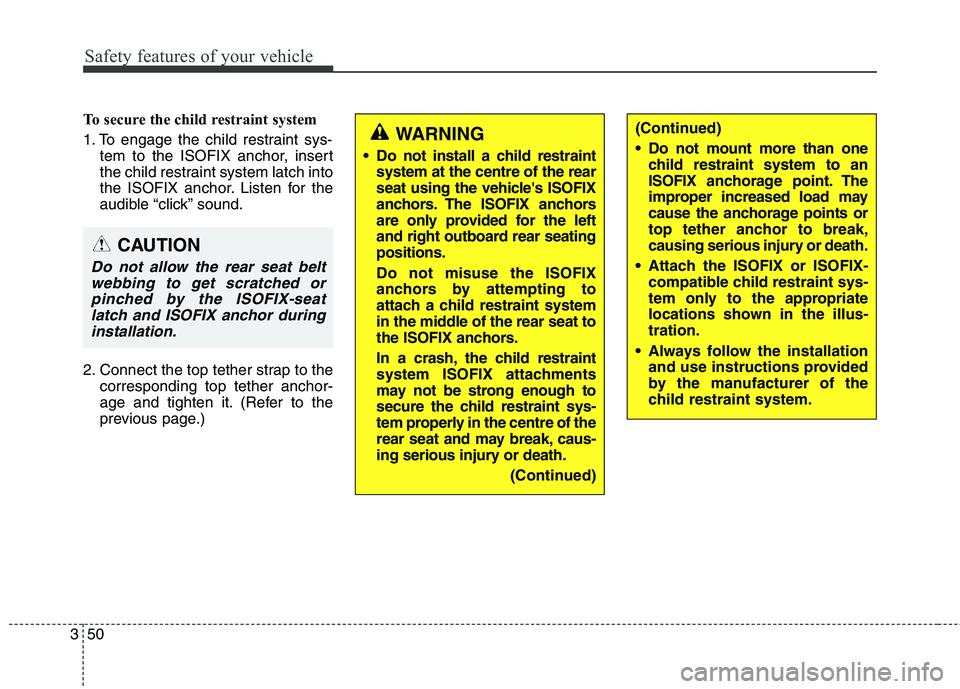
Safety features of your vehicle
50
3
To secure the child restraint system
1. To engage the child restraint sys-
tem to the ISOFIX anchor, insert
the child restraint system latch into
the ISOFIX anchor. Listen for the
audible “click” sound.
2. Connect the top tether strap to the corresponding top tether anchor-
age and tighten it. (Refer to the
previous page.)
CAUTION
Do not allow the rear seat belt
webbing to get scratched orpinched by the ISOFIX-seat latch and ISOFIX anchor duringinstallation.
WARNING
Do not install a child restraint system at the centre of the rear
seat using the vehicle's ISOFIX
anchors. The ISOFIX anchors
are only provided for the left
and right outboard rear seatingpositions. Do not misuse the ISOFIX
anchors by attempting to
attach a child restraint system
in the middle of the rear seat to
the ISOFIX anchors.
In a crash, the child restraint
system ISOFIX attachments
may not be strong enough to
secure the child restraint sys-
tem properly in the centre of the
rear seat and may break, caus-
ing serious injury or death.
(Continued)(Continued)
Do not mount more than onechild restraint system to an
ISOFIX anc horage point. The
improper increased load may
cause the anchorage points or
top tether anchor to break,
causing serious injury or death.
Attach the ISOFIX or ISOFIX- compatible child restraint sys-
tem only to the appropriate
locations shown in the illus-tration.
Always follow the installation and use instructions provided
by the manufacturer of the
child restraint system.
Page 69 of 723
351
Safety features of your vehicle
Suitability of each seating position for ISOFIX child restraint systems according to ECE regulations
IUF = Suitable for ISOFIX forward child restraints systems of universal category approved for use in the mass group.
IL = Suitable for particular ISOFIX child restraints systems (CRS) approved for this vehicle type according to ECE R44.These ISOFIX CRS are those of the "specific vehicle", "restricted" or "semi-universal" categories.
X = ISOFIX position not suitable for ISOFIX child restraint system in this mass group and/or this size class.
Mass GroupSize
ClassFixture
Vehicle ISOFIX positions
1st row2nd row3rd row
PassengerLHCTRRHLHCTRRH
CarrycotFISO/L1XXXXXN/AX
GISO/L2XXXXXN/AX
0 : UP to 10kgEISO/R1XILXILXN/AX
0+ : UP to 13kg
EISO/R1XILXILXN/AX
DISO/R2XILXILXN/AX
CISO/R3XILXILXN/AX
I : 9 to 18kg
DISO/R2XILXILXN/AX
CISO/R3XILXILXN/AX
BISO/F2XIUFXIUFXN/AX
B1ISO/F2XXIUFXIUFXN/AX
AISO/F3XIUFXIUFXN/AX
Page 70 of 723
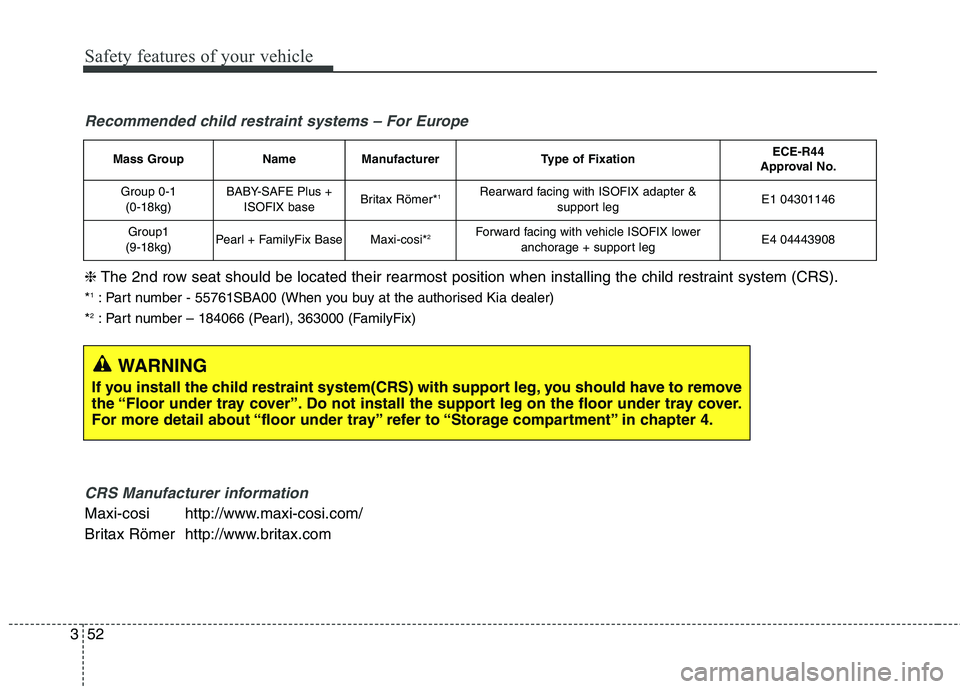
Safety features of your vehicle
52
3
Mass GroupNameManufacturerType of FixationECE-R44
Approval No.
Group 0-1
(0-18kg)BABY-SAFE Plus + ISOFIX baseBritax Römer* 1Rearward facing with ISOFIX adapter &
support legE1 04301146
Group1
(9-18kg)Pearl + FamilyFix BaseMaxi-cosi* 2Forward facing with vehicle ISOFIX lower
anchorage + support legE4 04443908
Recommended child restraint systems – For Europe
CRS Manufacturer information
Maxi-cosi http://www.maxi-cosi.com/
Britax Römer http://www.britax.com
❈
The 2nd row seat should be located their rearmost position when installing the child restraint system (CRS).
* 1
: Part number - 55761SBA00 (When you buy at the authorised Kia dealer)
* 2
: Part number – 184066 (Pearl), 363000 (FamilyFix)
WARNING
If you install the child restraint system(CRS) with support leg, you should have to remove
the “Floor under tray cover”. Do not install the support leg on the floor under tray cover.
For more detail about “floor under tray” refer to “Storage compartment” in chapter 4.
Page 74 of 723
Safety features of your vehicle
56
3
Front passenger's air bag warn-
ing label for child seatIn addition, we recommend that you
do not place front-facing child
restraints in the front passenger’s
seat either. If the front passenger air
bag inflates, it could cause serious or
fatal injuries to the child.
If your vehicle is equipped with the
passenger’s front air bag ON/OFF
switch, you can activate or deactivate
the front passenger’s air bag when
necessary.
For more details, please refer to
"Passenger’s front air bag ON/OFF
switch" in this chapter. (if equipped)
OYDESA2042
OJD032059
■ Type A
■ Type B
WARNING
Never place a rear facing child
restraint in the front passenger
seat, unless the passenger-side
air bag is deactivated. An inflat-
ing passenger-side air bag
could impact the rear-facing
child restraint and kill the child.
Page 75 of 723
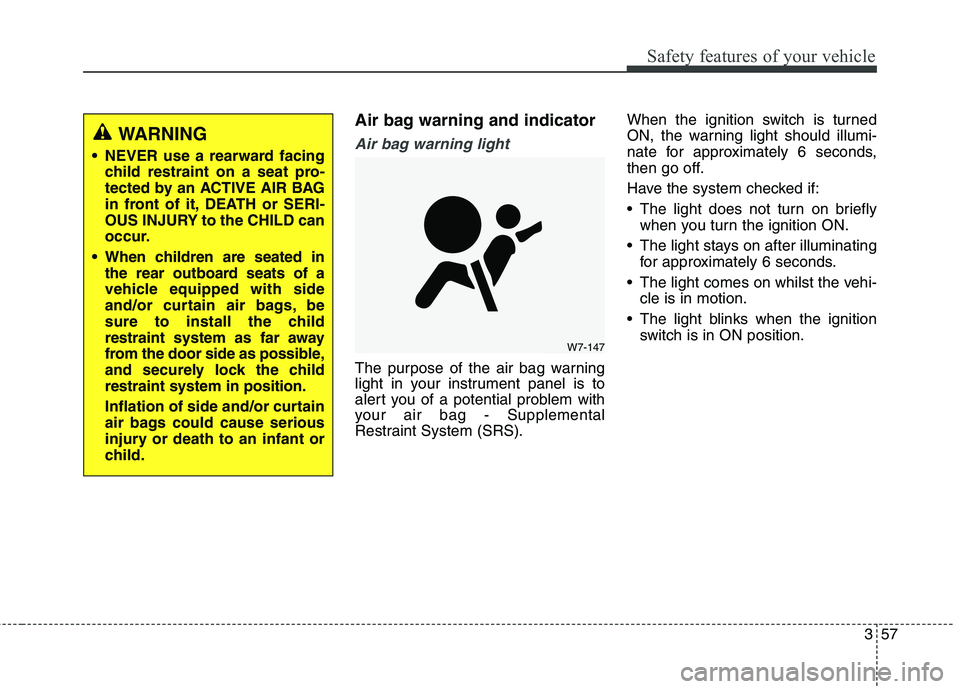
357
Safety features of your vehicle
Air bag warning and indicator
Air bag warning light
The purpose of the air bag warning
light in your instrument panel is to
alert you of a potential problem with
your air bag - Supplemental
Restraint System (SRS).When the ignition switch is turned
ON, the warning light should illumi-
nate for approximately 6 seconds,
then go off.
Have the system checked if:
The light does not turn on briefly
when you turn the ignition ON.
The light stays on after illuminating for approximately 6 seconds.
The light comes on whilst the vehi- cle is in motion.
The light blinks when the ignition switch is in ON position.
W7-147
WARNING
NEVER use a rearward facing child restraint on a seat pro-
tected by an ACTIVE AIR BAG
in front of it, DEATH or SERI-
OUS INJURY to the CHILD can
occur.
When children are seated in the rear outboard seats of a
vehicle equipped with side
and/or curtain air bags, be
sure to install the child
restraint system as far away
from the door side as possible,
and securely lock the childrestraint system in position.
Inflation of side and/or curtain
air bags could cause serious
injury or death to an infant or
child.
Page 80 of 723
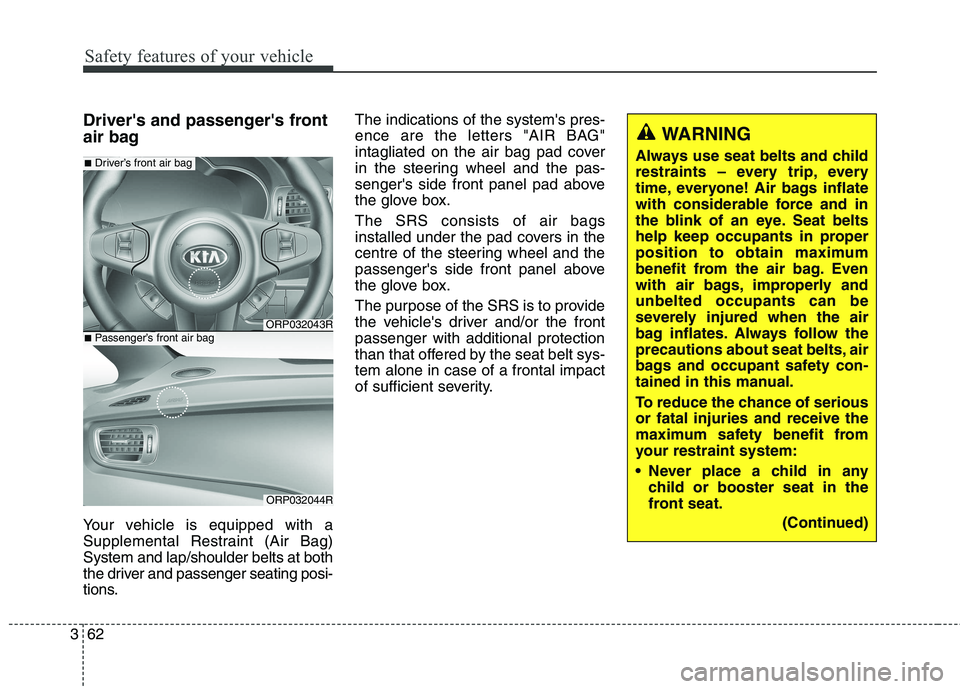
Safety features of your vehicle
62
3
Driver's and passenger's front
air bag
Your vehicle is equipped with a
Supplemental Restraint (Air Bag)System and lap/shoulder belts at both
the driver and passenger seating posi-
tions. The indications of the system's pres-
ence are the letters "AIR BAG"
intagliated on the air bag pad cover
in the steering wheel and the pas-
senger's side front panel pad above
the glove box. The SRS consists of air bags
installed under the pad covers in the
centre of the steering wheel and the
passenger's side front panel above
the glove box.
The purpose of the SRS is to provide
the vehicle's driver and/or the frontpassenger with additional protection
than that offered by the seat belt sys-tem alone in case of a frontal impact
of sufficient severity.
ORP032043R
■
Driver’s front air bag
ORP032044R
■Passenger’s front air bag
WARNING
Always use seat belts and child
restraints – every trip, every
time, everyone! Air bags inflate
with considerable force and in
the blink of an eye. Seat belts
help keep occupants in proper
position to obtain maximum
benefit from the air bag. Even
with air bags, improperly andunbelted occupants can be
severely injured when the air
bag inflates. Always follow the
precautions about seat belts, air
bags and occupant safety con-
tained in this manual.
To reduce the chance of serious or fatal injuries and receive the
maximum safety benefit from
your restraint system:
Never place a child in any child or booster seat in the
front seat.
(Continued)
Page 81 of 723
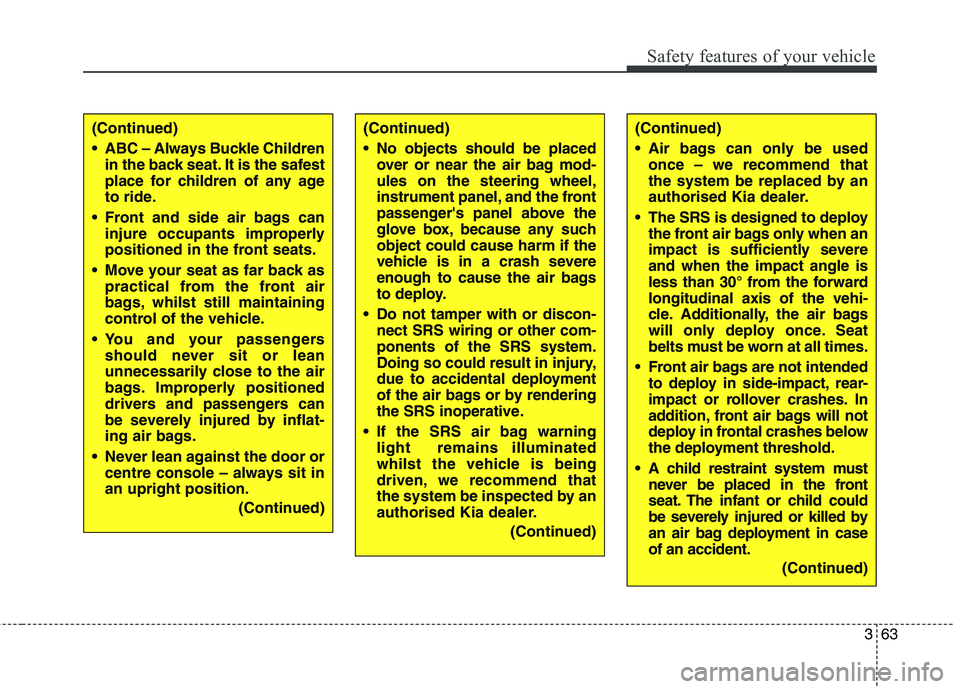
363
Safety features of your vehicle
(Continued)
ABC – Always Buckle Childrenin the back seat. It is the safest
place for children of any age
to ride.
Front and side air bags can injure occupants improperly
positioned in the front seats.
Move your seat as far back as practical from the front air
bags, whilst still maintaining
control of the vehicle.
You and your passengers should never sit or lean
unnecessarily close to the air
bags. Improperly positioned
drivers and passengers can
be severely injured by inflat-
ing air bags.
Never lean against the door or centre console – always sit inan upright position.
(Continued)(Continued)
No objects should be placedover or near the air bag mod- ules on the steering wheel,
instrument panel, and the front
passenger's panel above the
glove box, because any suchobject could cause harm if the
vehicle is in a crash severe
enough to cause the air bags
to deploy.
Do not tamper with or discon- nect SRS wiring or other com-ponents of the SRS system.
Doing so could result in injury,
due to accidental deployment
of the air bags or by rendering
the SRS inoperative.
If the SRS air bag warning light remains illuminated
whilst the vehicle is being
driven, we recommend that
the system be inspected by an
authorised Kia dealer.
(Continued)(Continued)
Air bags can only be usedonce – we recommend that
the system be replaced by an
authorised Kia dealer.
The SRS is designed to deploy the front air bags only when an
impact is sufficiently severeand when the impact angle is
less than 30° from the forwardlongitudinal axis of the vehi-
cle. Additionally, the air bags
will only deploy once. Seat
belts must be worn at all times.
Front air bags are not intended to deploy in side-impact, rear-
impact or rollover crashes. In
addition, front air bags will not
deploy in frontal crashes below
the deployment threshold.
A child restraint system must never be placed in the front
seat. The infant or child could
be severely injured or killed by
an air bag deployment in caseof an accident.
(Continued)
Page 82 of 723
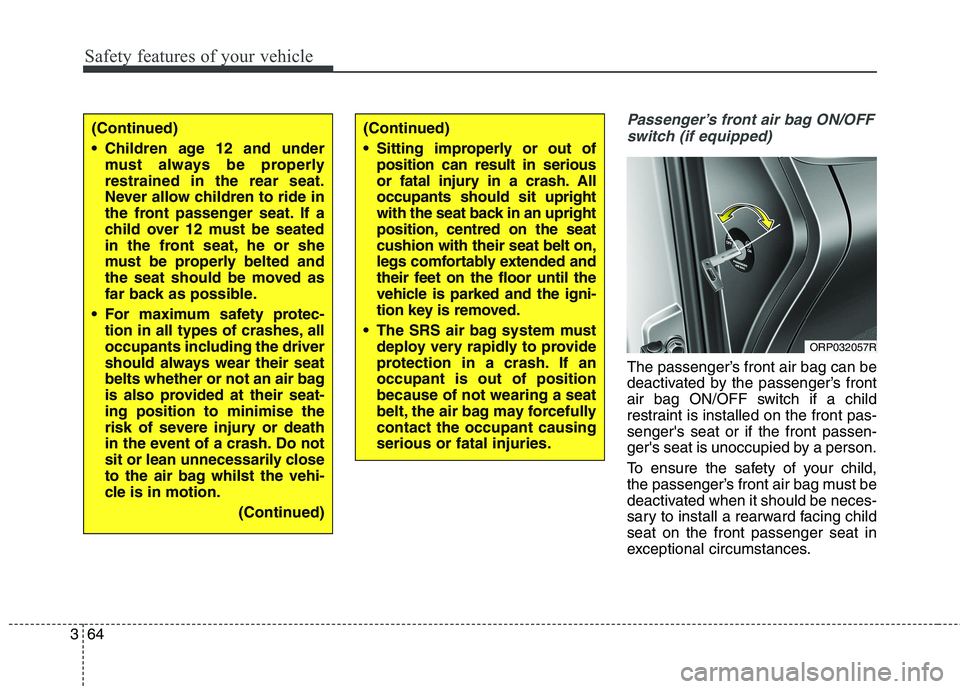
Safety features of your vehicle
64
3
Passenger’s front air bag ON/OFF
switch (if equipped)
The passenger’s front air bag can be
deactivated by the passenger’s front
air bag ON/OFF switch if a child
restraint is installed on the front pas-senger's seat or if the front passen-
ger's seat is unoccupied by a person.
To ensure the safety of your child,
the passenger’s front air bag must be
deactivated when it should be neces-
sary to install a rearward facing childseat on the front passenger seat in
exceptional circumstances.
(Continued)
Children age 12 and under must always be properly restrained in the rear seat.
Never allow children to ride in
the front passenger seat. If a
child over 12 must be seated
in the front seat, he or she
must be properly belted and
the seat should be moved as
far back as possible.
For maximum safety protec- tion in all types of crashes, all
occupants including the driver
should always wear their seat
belts whether or not an air bag
is also provided at their seat-ing position to minimise the
risk of severe injury or death
in the event of a crash. Do not
sit or lean unnecessarily close
to the air bag whilst the vehi-
cle is in motion.
(Continued)(Continued)
Sitting improperly or out ofposition can result in serious
or fatal injury in a crash. Alloccupants should sit upright
with the seat back in an upright
position, centred on the seatcushion with their seat belt on,
legs comfortably extended and
their feet on the floor until the
vehicle is parked and the igni-
tion key is removed.
The SRS air bag system must deploy very rapidly to provide
protection in a crash. If anoccupant is out of positionbecause of not wearing a seat
belt, the air bag may forcefullycontact the occupant causingserious or fatal injuries.
ORP032057R